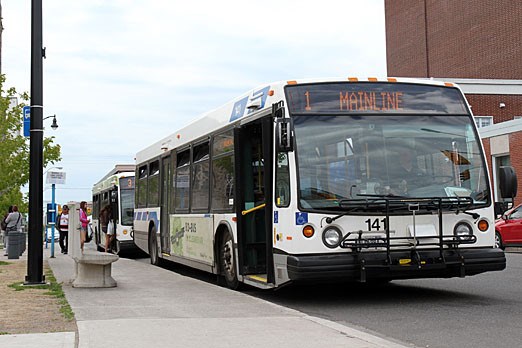THUNDER BAY — There's no date yet to end free bus rides in Thunder Bay, but the transit service is investigating how that could be accomplished while still protecting operators and the public from COVID-19.
Since March 21, passengers have been allowed to board buses at no charge, using only the rear door in order to avoid contact with the driver.
Although the waiver of fares and transfers has helped riders who have lost income because of the pandemic, it has also significantly impacted the city's budget.
A report from administration estimated that, by the end of May, Thunder Bay Transit suffered a $1.1 million loss in revenue.
The same report predicted an ongoing monthly impact of $400,000.
The transit department is preparing for the eventual return of pay-to-ride service by investigating the practicality of a temporary, protective "bio-shield" around operator compartments.
Manager Brad Loroff responded to an inquiry from Tbnewswatch by saying "It's something we are exploring, but nothing has been finalized and there has been no decision made to install as of yet."
The president of Amalgamated Transit Union Local 966, Ken Koza, said a plastic shield has already been installed on one bus on a trial basis.
The bus is being used for test runs, not for regular service, Koza said.
"We're looking at sort of a prototype, what it will look like. How big does it need to be? How much of an area does it need to cover, things like that. It's still early in the process," he said.
Koza said the testing process includes looking at things such as "glare and rattles, to see how it performs that way."
So far, he said, union members have given positive feedback.
The Ministry of Health has made recommendations for transit services including plexiglass windows between drivers and passengers, physical distancing by having fewer passsengers, enhanced cleaning of surfaces, and making alcohol-based hand sanitizer available upon entering and exiting a bus.
Koza said he believes transit agencies across Ontario are also waiting for additional direction from the Ministry of Transportation.
"The long-term goal is to get back to collecting some type of fare, but what does that look like?", he asked, explaining that drivers don't want to handle punch-passes or transfers.
"We need to have a conversation with transit about what it's going to look like to get back to collecting fare again. I don't think it's going to look like it was pre-COVID-19," Koza said.
He added that, once fares are reintroduced, he fully expects many people who are riding the bus unncessarily will stop doing so.
"We need people riding the bus for essential purposes. All it's doing is creating crowding on the buses."
Koza speculated that, given the time required to install the shields on all buses and work out details about handling fares, it could be at least four to six weeks before free rides come to an end.
Separately from the bio-shield experiment – and not connected to COVID-19 –Thunder Bay Transit also intends to install permanent driver safety barriers on all 48 buses to protect operators from violent passengers.
A pilot project is expected to begin in the coming weeks, with a target for completion of all installations by 2022.
